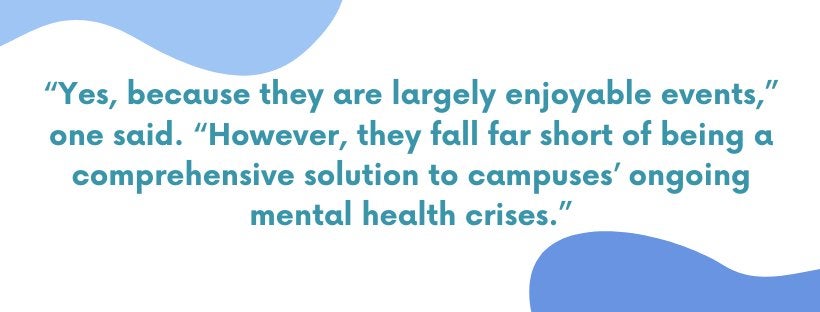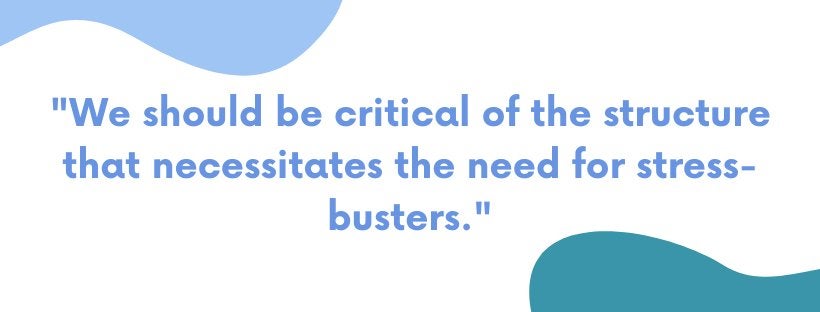It’s no secret that on campus student mental health resources often fall flat, failing to grant students the tools they actually need and offering what may seem like a consolation prize in their place. After all, if you’re ever on a college campus during midterms or finals season, you’re sure to notice a few things: students hunched over laptops in the library, empty coffee cups littered on the tables beside them, dorm room lights on after dark as everyone tries to cram in those last few bits of knowledge before sleep overtakes them, and… puppies.
If not puppies, it’s free hot chocolate. Or it’s neck and back rubs provided by fellow students. Maybe even a cry closet in the library. Whatever your school or student body decides to choose as a “stress-buster,” there’s no doubt brightly-colored flyers lining the hallways to call out to all the sleep-deprived passersby.
“Come relax with Student Life! Self-care on the quad! Take a break!”

These stress-busters are often contextualized within hotly-debated “safe spaces” on campus. In a controversial op-ed for The New York Times, Judith Shulevitz described one safe space at Brown University where students affected by a speaker on campus who planned to discuss sexual assault could go if they were upset.
“The room,” Shulevitz wrote, “was equipped with cookies, coloring books, bubbles, Play-Doh, calming music, pillows, blankets and a video of frolicking puppies, as well as students and staff members trained to deal with trauma.” She went on to argue that these spaces and activities serve only to “self-infantilize” students (a term she borrowed from Judith Shapiro, who argued a similar point in another essay) and that college students shouldn’t need to be protected from “triggering” ideas or events.
It may be true that coloring books and bubbles don’t exactly paint a picture of college students as “mature adults,” but Shulevitz’s take on the harm that these spaces and services can cause was contested by multiple publications, from The New Republic to The Washington Post to Slate. Most of these responses were focused on the political implications of safe spaces, but it’s clear that many of those within Shulevitz’s and Shapiro’s generation view arts and crafts and puppy-petting parties as not only unnecessary, but also beneath college students, who should be groomed into self-sufficient, “strong” adults.
Is this actually true? What’s the deal with stress-busters? Are they necessary? What do they do — if anything — for our mental health?
Stress-busters often make their appearance at tense times for the student body: midterms and finals are the most common, but contentious events like that of the controversial speaker at Brown can also create the need for a distraction. The 2016 election, in particular, gained media attention (and criticism) for providing students with safe spaces and distractions like hot chocolate and arts and crafts sessions.
Nobody’s saying that stress-busters are the be-all, end-all cure for the mental health crisis on college campuses; they’re offered in addition to the regular mental health services provided by universities, which include counseling centers with therapy sessions. But many students who do reach out to their counseling centers get less-than-fruitful results – 65 percent of respondents to Kaplan’s most recent Student Voice survey reported having fair or poor mental health, and 63 percent of those who reported poor mental health graded their college’s mental health services a C or lower. And where on-campus help fails, getting off-campus help is generally more expensive (especially since some schools offer free sessions) and more time-consuming than simply walking over to the counseling center right after class.
Additionally, since university mental health service centers prioritize students in “crisis” (i.e. those at risk of suicide), students who are still struggling but aren’t in immediate danger find themselves pushed to the bottom of long waitlists, or feel like their problems aren’t dire enough or important enough to warrant going to therapy at all.

That’s where stress-busters come in: sometimes, you just need a break or a place to escape from your stressors for a bit — or sometimes, that’s all you have access to or can make time for.
So what students actually think of these stress-busters — do they like them? Do they actually find that these puppies and cookies make them feel, well, de-stressed?
When it came to the topic of stress-busters, we received almost identical answers from students from seven different schools: most students have a positive view of stress-busters and want them to continue to be offered on campus, but most also don’t view them as actual solutions for any of the problems they face on campus.
When asked if schools should continue to provide stress-busters as a resource for students, respondent’s unanimously answered, “Yes.” Their reasoning, however, was pretty telling:
“Yes, because they are largely enjoyable events,” one said. “However, they fall far short of being a comprehensive solution to campuses’ ongoing mental health crises.”
Another wrote, “Yes; while they’re not quite what they should be, a fraction of what is needed is better than nothing at all.”
And yet another student said, “Yes, because a little relief is better than no relief.”
These students, especially the latter two, seem to have accepted that their school’s regular mental health services are not going to provide them with the full extent (or any part) of what they need. To them, stress-busters are sometimes the only bit of brightness in a long day of studying and working and dealing with relationships, homesickness and all the other stressors that bear a constant weight on college students.

Their disillusionment with university administrations’ ability to serve student needs is not entirely unfounded, either. In fact, a lot of the time it’s students themselves who are offering these resources: Handing out free food on campus often falls under Student Government’s or clubs’ responsibilities. So while adults may admonish college kids for turning to arts and crafts when the going gets tough, something is better than the nothing they’re given.
There is, however, a possible danger in the notion of stress-busters. While they probably don’t mean much more than a few minutes of relaxation during a hard time, they could invite a kind of complacency from the student body and administration regarding the amount of stress college students are expected to bear in their daily lives. They’re quick fixes; a Band-Aid on a wound that requires major surgery. The presence of stress-busters on campus implies that stress is the norm, that college students should expect to feel bogged down by their responsibilities and expectations. Stress-busters work around that fact instead of attempting to examine it closer and ask why that is, whether it should be that way, and if not, how to fix it.

We come to college knowing that we’ll have to work hard and that it will be harder than high school, but that’s not to say that stress-busters shouldn’t continue to be present on college campuses. They absolutely should; in fact, they might well be imperative as long as the college mental health crisis continues — but we should be critical of the structure that necessitates the need for stress-busters.
As Barnard College student Idris O, who was interviewed by Her Campus about her own mental health experiences, says, “At its very core, Columbia is a catalyst for depression and anxiety and whatever other countless traumas they’re inflicting on students – and no amount of stress-busting is going to solve it.” She was speaking about her own university in particular, but the sentiment applies to other top-tier, “tough” schools: stress should be dealt with at the structural level — how many classes are students expected to take?, How heavy of a workload do these classes have?, etc. — instead of in the aftermath.

Some schools, admittedly, have taken baby steps toward this approach. Columbia itself, for example, lowered its maximum credit limit so students won’t take as many classes per semester (though some argue this causes more of a burden). But for many, students still feel most comfortable — or have to — turning to their own devices to fix the structural issue of stress on campus.
But they shouldn’t have to.
Simply put, college students aren’t the “wilting flowers” that older generations make them out to be, who can’t handle a bit of pressure or opinions that disagree with their own without getting “triggered.” They’re human beings who are put under an immense amount of stress (and young people are also dealing with more anxiety than ever before). If petting a puppy and drawing in a coloring book for a couple minutes is all college students feel that they have for mental health support, perhaps the problem isn’t so much with the “childishness” of the arts and crafts and puppies as it is with the institutions that aren’t doing enough to support their students.
If you or someone you know is in crisis, please contact the National Suicide Prevention Lifeline.
Studies Referenced:
Kaplan (2021) Student Voice Survey.
This article was originally published as a part of Her Campus’s ‘Anxiety on Campus: Feeling Seen & Speaking Out’, a project dedicated to highlighting mental health and anxiety on campus.


